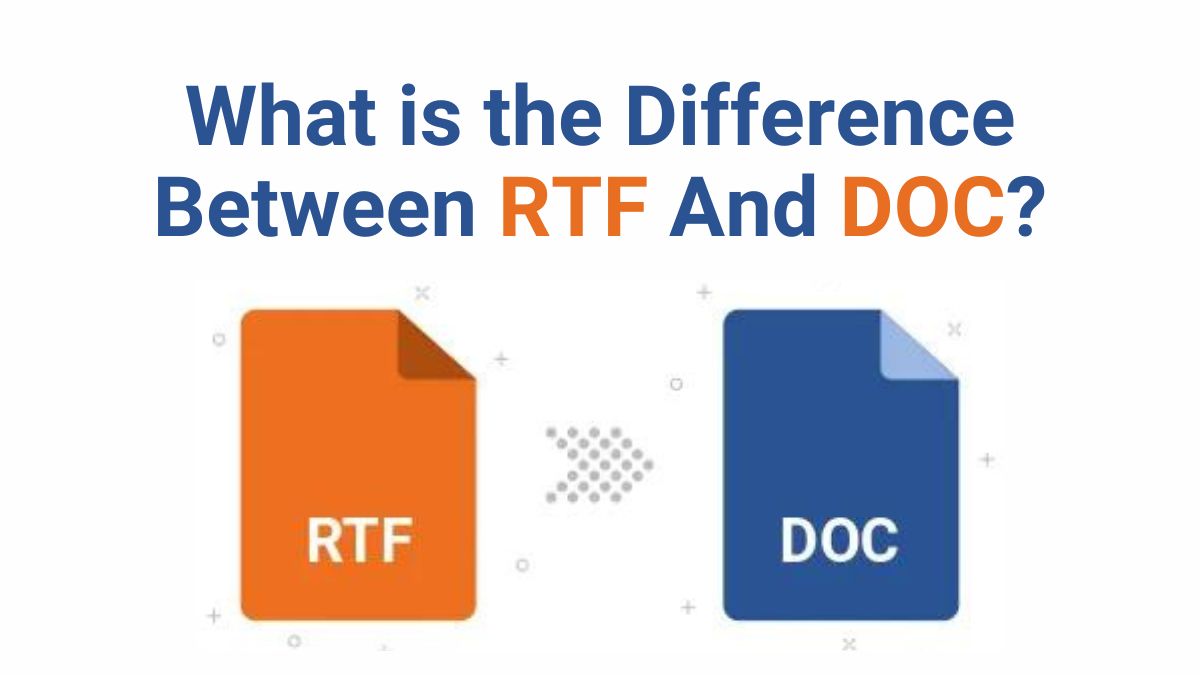
In the digital age, text documents are essential. They are part of our daily lives, both personally and professionally. You might be writing a resume, a report, or a simple note. The format you use to save your text greatly impacts how it’s used, shared, and preserved. You may encounter two common formats: RTF (Rich Text Format) and DOC (Document File Format). Understanding these formats’ differences will help you make informed decisions. You can choose which one to use for your needs.
What is RTF?
Rich Text Format (RTF) is a proprietary document file format created by Microsoft in 1987. It was meant to be a cross-platform format. Any word processing software, on any operating system, could read and write it.
Key Features of RTF:
- Platform Independence: One of RTF’s primary advantages is its cross-platform compatibility. An RTF file created on a Windows computer can be opened elsewhere. Mac, Linux, or other systems can edit it with compatible software.
- Basic Formatting: It includes bold, italics, and underlining. Also, font and color changes. It also supports more advanced formatting options. These include tables, bullets, and text alignment.
- Simplicity and Compatibility: RTF files are simple and lightweight. This makes them quick to transfer and open. Their simplicity also makes them highly compatible with much software. This includes basic text editors and advanced word processors.
- No Embedded Objects: RTF does not support embedding multimedia. It can’t handle videos or audio. It focuses mainly on text and basic formatting.
What is DOC?
The DOC format is another proprietary document file format. Microsoft created it for its Microsoft Word software. The format has changed a lot since it started in the early 1980s. The biggest change was the introduction of DOCX in 2007 with Microsoft Word 2007. It’s a more modern and efficient version of the DOC format.
Key Features of DOC:
- Rich Formatting Capabilities: The DOC format allows many formatting options. The page has complex tables. It has many font choices. It has different styles for headings, paragraphs, and lists. It also allows you to embed multimedia elements such as images, audio, and video.
- Advanced Features: DOC files can have many advanced features. These include macros, forms, and custom templates. These features make DOC an effective tool for developing complex and professional documents.
- Microsoft Integration: DOC files are a proprietary format created by Microsoft. They are tightly integrated with other Microsoft Office apps. This integration ensures a seamless experience when working in the Microsoft ecosystem.
- File Size and Performance: DOC files may be larger than RTF files. DOC files support extensive formatting and embedded objects. However, DOCX made files much smaller and faster.
Comparing RTF and DOC: A Detailed Analysis
1. Formatting Capabilities
RTF: RTF provides basic text formatting but lacks the advanced features found in DOC. It is fine for simple documents. But, it falls short when layouts are complex or media is needed.
DOC: DOC excels at providing numerous formatting options. Whether you’re working on a detailed report, an academic paper, or a professional presentation, DOC has the tools you need. You can embed images, videos, and other objects. This makes it an adaptable option for complex documents.
2. Compatibility and Platform Independence
RTF: One of RTF’s key advantages is its platform independence. It can be opened and edited with most word-processing software. This makes it great for sharing documents across systems.
DOC: Most people associate DOC with Microsoft Word. But, it can also be opened in other word processors like Google Docs and LibreOffice. However, using non-Microsoft software may result in minor compatibility issues or formatting discrepancies.
3. File Size and Performance
RTF: RTF files are simple. They are usually smaller. They need less power to open and edit. This makes them ideal for drafting and transferring documents quickly.
DOC: DOC files can be quite large. They are huge if they contain multimedia and complex formatting. This can impair performance, especially on older or less powerful devices. But, DOCX has fixed some of these concerns. It did this by improving file compression.
4. Advanced Features
RTF: RTF has limited advanced features. It does not support macros, forms, or custom templates. This makes it unsuitable for creating interactive or highly structured documents.
DOC: DOC’s advanced features make it an effective tool for professional use. You can include macros, forms, and custom templates. They let you make interactive documents and automate tasks.
5. Security
RTF: RTF files are simple. They are less vulnerable to malware and viruses than DOC files. The lack of macros and embedded objects lowers the risk. It lowers the risk of malicious code being executed.
DOC: DOC files may contain macros. Macros automate tasks but can be used by malware. You must be cautious when opening DOC files from unknown sources. This caution is critical to avoid security risks.
Use Cases for RTF and DOC
When to Use RTF
- Simple Text Documents: For documents that require only basic formatting, RTF is an excellent choice. It is straightforward and ensures compatibility across different platforms.
- Cross-Platform Sharing: If you need to share a document with someone who may not have Microsoft Word, RTF is a safe bet. Its wide compatibility ensures that the recipient can open and edit the document without issues.
- Quick Drafts: When you need to jot down notes or create a quick draft, RTF’s simplicity and small file size make it an efficient choice.
When to Use DOC
- Professional Documents: For documents that require a professional appearance with complex formatting and multimedia elements, DOC is the preferred format. Its extensive features support the creation of polished, professional-quality documents.
- Microsoft Ecosystem: If you work primarily within the Microsoft ecosystem, DOC files provide a seamless experience, especially when integrating with other Microsoft Office applications.
- Advanced Features: For documents that require the use of macros, forms, or custom templates, DOC is the necessary format. Its advanced capabilities support a wide range of professional and interactive documents.
Conclusion
The choice between RTF and DOC depends on your needs and the document’s context. RTF provides simplicity, broad compatibility, and security for basic text documents. It is great for sharing across platforms and for quick drafts. DOC offers many formatting options and advanced features. It integrates deeply with Microsoft Office. This makes it the top choice for complex documents by pros.
Understanding these differences helps you to choose the best format for your needs. This ensures that your documents work well and are easy to use. You may prefer RTF’s simplicity or DOC’s power. Each format has unique benefits. You can use them to improve your document creation and sharing.




